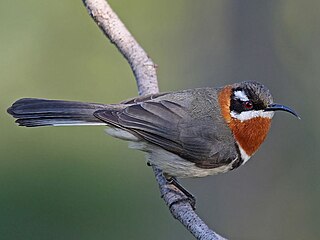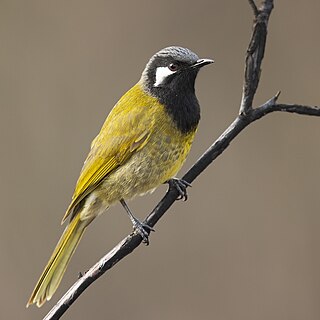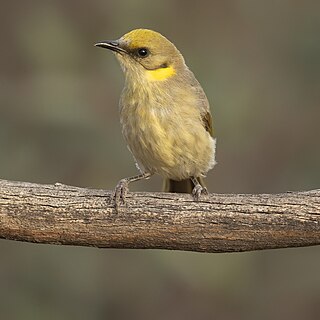
The scarlet myzomela or scarlet honeyeater is a small passerine bird of the honeyeater family Meliphagidae native to Australia. It was first described by English ornithologist John Latham in 1801. At 9 to 11 cm long, it is the smallest honeyeater in Australia. It has a short tail and relatively long down-curved bill. It is sexually dimorphic; the male is a striking bright red with black wings, while the female is entirely brown. The species is more vocal than most honeyeaters, and a variety of calls have been recorded, including a bell-like tinkling.

The white-plumed honeyeater is a small passerine bird endemic to Australia. White-plumed honeyeaters are common around water and are often seen in backyards and suburbs with vegetation cover.

The yellow-faced honeyeater is a small to medium-sized bird in the honeyeater family, Meliphagidae. It takes its common and scientific names from the distinctive yellow stripes on the sides of its head. Its loud, clear call often begins twenty or thirty minutes before dawn. It is widespread across eastern and southeastern Australia, in open sclerophyll forests from coastal dunes to high-altitude subalpine areas, and woodlands along creeks and rivers. Comparatively short-billed for a honeyeater, it is thought to have adapted to a diet of flies, spiders, and beetles, as well as nectar and pollen from the flowers of plants, such as Banksia and Grevillea, and soft fruits. It catches insects in flight as well as gleaning them from the foliage of trees and shrubs.

The yellow-tufted honeyeater is a passerine bird found in the south-east ranges of Australia. A predominantly black and yellow honeyeater, it is split into four subspecies.

The western spinebill is a honeyeater found in the heath and woodland of south-western Australia. Ranging between 12–16 centimetres (4.7–6.3 in) long, it weighs around 10 grams (0.35 oz). It has a black head, gray back and wings, with a red band behind its neck and from its throat to its breast. Its curved bill is long and slender.

The white-eared honeyeater is a medium-sized honeyeater found in Australia. It is a member of the family Meliphagidae which has 190 recognised species with about half of them found in Australia. This makes them members of the most diverse family of birds in Australia. White-eared honeyeaters are easily identifiable by their olive-green body, black head and white ear-patch.

The brown honeyeater is a species of bird in the family Meliphagidae. It belongs to the honeyeaters, a group of birds which have highly developed brush-tipped tongues adapted for nectar feeding. Honeyeaters are found mainly in Australia, New Guinea, and parts of Indonesia, but the brown honeyeater is unique in that it also occurs on the island of Bali, making it the only honeyeater to be found west of the Wallace Line, the biogeographical boundary between the Australian-Papuan and Oriental zoogeographical regions.

The singing honeyeater is a small bird found in Australia, and is part of the honeyeater family Meliphagidae. The bird lives in a wide range of shrubland, woodland, and coastal habitat. It is relatively common and is widespread right across Australia west of the Great Dividing Range, through to the west coast and on Western Australian coastal islands. It does not occur in other countries.

The striped honeyeater is a passerine bird of the honeyeater family, Meliphagidae, found in Australia. It is a medium-sized honeyeater, about 23 cm (9.1 in) in length. Both sexes are a light greyish brown with dark brown centres to the feathers, which give the appearance of stripes. The stripes are particularly distinct on the head and back of the neck. While it is found mainly in inland eastern Australia where it inhabits the drier open forest, it is also found in coastal swamp forest from southeast Queensland to the central coast of New South Wales.

The spiny-cheeked honeyeater is the only species in the genus Acanthagenys. It is large for a honeyeater, ranging from 22 to 27 centimeters tall and weighing around 52 grams. The birds are sociable, aggressive, and often observed foraging in large flocks.

The banded honeyeater is a species of honeyeater in the family Meliphagidae with a characteristic narrow black band across its white underparts. It is endemic to tropical northern Australia.

The yellow-throated honeyeater is a species of passerine bird in the honeyeater family Meliphagidae. It is similar in behaviour and appearance to the white-eared honeyeater and is endemic to Australia's island state of Tasmania. It was formerly considered a pest of orchards.

The fuscous honeyeater is a species of bird in the family Meliphagidae. It is endemic to eastern Australia, where it inhabits subtropical and tropical dry forests.

The grey-headed honeyeater is a species of bird in the family Meliphagidae. It is endemic to Australia.

The yellow-plumed honeyeater is a species of bird in the family Meliphagidae. It is endemic to Australia, where it inhabits temperate forests and Mediterranean-type shrubby vegetation.

The grey-fronted honeyeater is a species of bird in the family Meliphagidae. It is endemic to Australia. Its natural habitat is Mediterranean-type shrubby vegetation. The grey-fronted honeyeater was originally described in 1841 by English ornithologist John Gould as Lichenostomus plumulus. It was moved to the genus Ptilotula after a molecular phylogenetic analysis, published in 2011, showed that Lichenostomus was polyphyletic.

The varied honeyeater is a species of bird in the family Meliphagidae. It is found in coastal areas of New Guinea and eastern Cape York Peninsula in Queensland, Australia. Its natural habitat is subtropical or tropical mangrove forests.

The red-headed myzomela or red-headed honeyeater is a passerine bird of the honeyeater family Meliphagidae found in Australia, Indonesia, and Papua New Guinea. It was described by John Gould in 1840. Two subspecies are recognised, with the nominate race M. e. erythrocephala distributed around the tropical coastline of Australia, and M. e. infuscata in New Guinea. Though widely distributed, the species is not abundant within this range. While the IUCN lists the Australian population of M. e. infuscata as being near threatened, as a whole the widespread range means that its conservation is of least concern.

Gilbert's honeyeater, also known as the Swan River honeyeater or western white-naped honeyeater, is a passerine bird of the honeyeater family Meliphagidae native to southwestern Australia. A mid-sized honeyeater, it is olive-green above and white below, with a black head, nape and throat and a white patch over the eye and a white crescent-shaped patch on the nape. The bill is brownish-black and the eyes a dull red. The sexes have similar plumage.

Ptilotula is a genus of honeyeater consisting of species occurring in Australia and Papua New Guinea. The genus consists of six former members of Lichenostomus, and was created after a molecular analysis showed the genus was polyphyletic. The International Ornithologists' Union accepted this change and officially included the genus in reference lists from 2013. The type species is the yellow-tinted honeyeater. Birds in this genus typically occupy dry open forest and woodland habitats, and can be found in arid and semi-arid environments.





















